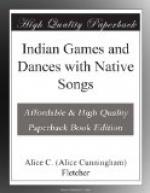The player who “holds the reeds” is thought to have the advantage; that is why lots are drawn at the beginning to decide who shall have that part in the game. The player holding the reeds aims to make the guessing as difficult as possible by deftness in hiding the banded reed, so as to keep his advantage.
Every time a guess is made the reeds of the bunch guessed must at once be dropped on the mat, that all may see the reeds while the guesser searches among them for the marked reed. If he cannot find it, the singers who stand behind him call out that a point has been lost, take a counter from his pile and place it at the right hand of the player holding the reeds, who at once drops all the game-reeds on the middle of the mat, to be again taken up by him, shuffled and divided behind his back, when he resumes the waving of the bunches of reeds blown by the wind and the guesser who lost starts to make another guess. Should he be successful, the counter he had lost would be taken back and placed at his right hand. In this manner counters lost can be reclaimed, until one or the other of the players has won and been able to hold the number of counters required for the game.
The presentation of the little drama of this game rhythmically affords an opportunity for considerable dramatic action and yields pleasure both to the performers and to the spectators. This game was much played among the tribes where it was known.
III
HAND GAME
INTRODUCTORY NOTE.—This game, Dr. Culin states, is played among eighty-one Indian tribes of the United States. The game bears different names in the various languages of these tribes. Hand Game is a descriptive term and not a translation of any native name; it refers to the fact that the object is held in the hand during the play. The following form of this game is the way it was formerly played among the Nez Perce Indians of the State of Idaho. Lewis and Clark, who were the first white men to record their meeting with these Indians, mention this game, and Capt. Bonneville gives an account of it when he visited the tribe during the third decade of the last century.
Properties.—A bone or wooden bead about two inches in length and half an inch in thickness; thirty counting sticks (these are sometimes spoken of as arrows, and there are indications that they were once arrows—the arrows of the twin gods); a mat oblong in shape; two logs or pieces of board about the length of the mat, and as many sticks (to be used as drum-sticks) as players can sit on one side of the mat.
Directions.—The mat should be laid east and west, the logs or boards put on the north and south edges and the counting sticks placed in two piles of fifteen each on the ends of the mat. The players sit on the ground, a row on each side of the mat to the north and south. Lots are drawn to decide which side shall have the bead “in hand.” The Leader and the singers must always stand behind the row of players who have the bead “in hand.” The opposite side must have the drum-sticks and beat on the log or board in time with the singers.




